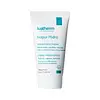What's inside
What's inside
 Key Ingredients
Key Ingredients

 Benefits
Benefits

 Concerns
Concerns

 Ingredients Side-by-side
Ingredients Side-by-side

Water
Skin ConditioningHydrogenated Polyisobutene
EmollientGlycerin
HumectantEthylhexyl Stearate
EmollientPropanediol
SolventCetyl Alcohol
EmollientButyrospermum Parkii Butter
Skin ConditioningSimmondsia Chinensis Seed Oil
EmollientCyclopentasiloxane
EmollientMethyl Methacrylate Crosspolymer
Dimethicone
EmollientCyclohexasiloxane
EmollientGlyceryl Stearate
EmollientPEG-100 Stearate
Cera Alba
EmollientSodium Benzoate
MaskingParaffinum Liquidum
EmollientGlyceryl Acrylate/Acrylic Acid Copolymer
HumectantAcrylates/C10-30 Alkyl Acrylate Crosspolymer
Emulsion StabilisingBisabolol
MaskingCarbomer
Emulsion StabilisingChlorphenesin
AntimicrobialPhenoxyethanol
PreservativeTocopheryl Acetate
AntioxidantChlorhexidine Digluconate
AntimicrobialSilica
AbrasiveViola Tricolor Extract
EmollientSodium Hydroxide
BufferingEthylhexylglycerin
Skin ConditioningTocopherol
AntioxidantWater, Hydrogenated Polyisobutene, Glycerin, Ethylhexyl Stearate, Propanediol, Cetyl Alcohol, Butyrospermum Parkii Butter, Simmondsia Chinensis Seed Oil, Cyclopentasiloxane, Methyl Methacrylate Crosspolymer, Dimethicone, Cyclohexasiloxane, Glyceryl Stearate, PEG-100 Stearate, Cera Alba, Sodium Benzoate, Paraffinum Liquidum, Glyceryl Acrylate/Acrylic Acid Copolymer, Acrylates/C10-30 Alkyl Acrylate Crosspolymer, Bisabolol, Carbomer, Chlorphenesin, Phenoxyethanol, Tocopheryl Acetate, Chlorhexidine Digluconate, Silica, Viola Tricolor Extract, Sodium Hydroxide, Ethylhexylglycerin, Tocopherol
Water
Skin ConditioningGlycerin
HumectantC9-12 Alkane
SolventPEG-8
HumectantButyrospermum Parkii Butter
Skin ConditioningCera Alba
EmollientCetyl Alcohol
EmollientDiethylhexyl Succinate
EmollientNylon-12
Caprylyl Glycol
EmollientLactitol
HumectantXylitol
HumectantStearic Acid
CleansingPalmitic Acid
EmollientEthylhexylglycerin
Skin ConditioningXanthan Gum
EmulsifyingSclerotium Gum
Emulsion StabilisingCoco-Caprylate/Caprate
EmollientCetyl Hydroxyethylcellulose
Emulsion StabilisingSodium Polyacrylate
AbsorbentSodium Hydroxide
BufferingHydrated Silica
AbrasiveSilica Dimethyl Silylate
EmollientDisodium Phosphate
BufferingSodium Phosphate
BufferingWater, Glycerin, C9-12 Alkane, PEG-8, Butyrospermum Parkii Butter, Cera Alba, Cetyl Alcohol, Diethylhexyl Succinate, Nylon-12, Caprylyl Glycol, Lactitol, Xylitol, Stearic Acid, Palmitic Acid, Ethylhexylglycerin, Xanthan Gum, Sclerotium Gum, Coco-Caprylate/Caprate, Cetyl Hydroxyethylcellulose, Sodium Polyacrylate, Sodium Hydroxide, Hydrated Silica, Silica Dimethyl Silylate, Disodium Phosphate, Sodium Phosphate
Ingredients Explained
These ingredients are found in both products.
Ingredients higher up in an ingredient list are typically present in a larger amount.
This ingredient is also known as shea butter. It is an effective skin hydrator and emollient.
Emollients help soothe and soften your skin. It does this by creating a protective film on your skin. This barrier helps trap moisture and keeps your skin hydrated. Emollients may be effective at treating dry or itchy skin.
Shea butter is rich in antioxidants. Antioxidants help fight free-radicals, or molecules that may harm the body. It is also full of fatty acids including stearic acid and linoleic acid. These acids help replenish the skin and keep skin moisturized.
While Shea Butter has an SPF rating of about 3-4, it is not a sunscreen replacement.
Shea butter may not be fungal acne safe. We recommend speaking with a professional if you have any concerns.
Learn more about Butyrospermum Parkii ButterCera alba is beeswax, or the wax used by bees to make honeycombs. It is a texture-enhancer and emollient. A study from 2003 found beeswax to be a stronger emollient than ingredients such as petroleum jelly.
As an emollient, beeswax helps hydrate the skin by creating a barrier on top. This barrier traps moisture in.
Emulsifiers help prevent ingredients from separating. This helps create consistent texture.
The structure of beeswax is mainly long-chain alcohols and the esters of fatty acids.
There are three types of beeswax: yellow, white, and absolute. Yellow is pure beeswax taken from the honeycomb. White beeswax is created by filtering or bleaching yellow beeswax. Absolute beeswax is created by treating beeswax with alcohol. Beeswax used in cosmetics are purified.
Beeswax has been used throughout history and even in prehistoric times. Some common uses for beeswax still used today are making candles, as a waterproofing agent, and polish for leather.
Learn more about Cera AlbaCetyl Alcohol is a fatty alcohol. Fatty Alcohols are most often used as an emollient or to thicken a product.
Its main roles are:
Though it has "alcohol" in the name, it is not related to denatured alcohol or ethyl alcohol.
The FDA allows products labeled "alcohol-free" to have fatty alcohols.
Learn more about Cetyl AlcoholEthylhexylglycerin (we can't pronounce this either) is commonly used as a preservative and skin softener. It is derived from glyceryl.
You might see Ethylhexylglycerin often paired with other preservatives such as phenoxyethanol. Ethylhexylglycerin has been found to increase the effectiveness of these other preservatives.
Glycerin is already naturally found in your skin. It helps moisturize and protect your skin.
A study from 2016 found glycerin to be more effective as a humectant than AHAs and hyaluronic acid.
As a humectant, it helps the skin stay hydrated by pulling moisture to your skin. The low molecular weight of glycerin allows it to pull moisture into the deeper layers of your skin.
Hydrated skin improves your skin barrier; Your skin barrier helps protect against irritants and bacteria.
Glycerin has also been found to have antimicrobial and antiviral properties. Due to these properties, glycerin is often used in wound and burn treatments.
In cosmetics, glycerin is usually derived from plants such as soybean or palm. However, it can also be sourced from animals, such as tallow or animal fat.
This ingredient is organic, colorless, odorless, and non-toxic.
Glycerin is the name for this ingredient in American English. British English uses Glycerol/Glycerine.
Learn more about GlycerinSodium Hydroxide is also known as lye or caustic soda. It is used to adjust the pH of products; many ingredients require a specific pH to be effective.
In small amounts, sodium hydroxide is considered safe to use. However, large amounts may cause chemical burns due to its high alkaline.
Your skin has a natural pH and acid mantle. This acid mantle helps prevent harmful bacteria from breaking through. The acid mantle also helps keep your skin hydrated.
"Alkaline" refers to a high pH level. A low pH level would be considered acidic.
Learn more about Sodium HydroxideWater. It's the most common cosmetic ingredient of all. You'll usually see it at the top of ingredient lists, meaning that it makes up the largest part of the product.
So why is it so popular? Water most often acts as a solvent - this means that it helps dissolve other ingredients into the formulation.
You'll also recognize water as that liquid we all need to stay alive. If you see this, drink a glass of water. Stay hydrated!
Learn more about Water